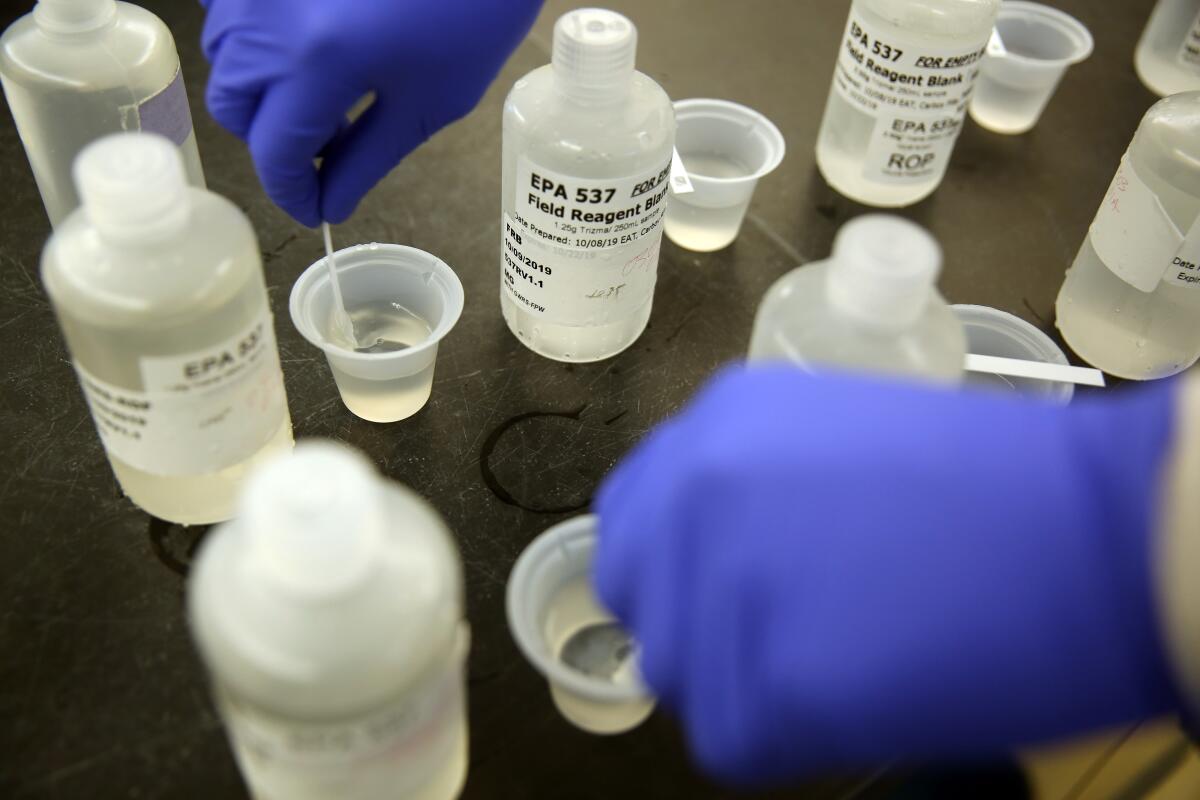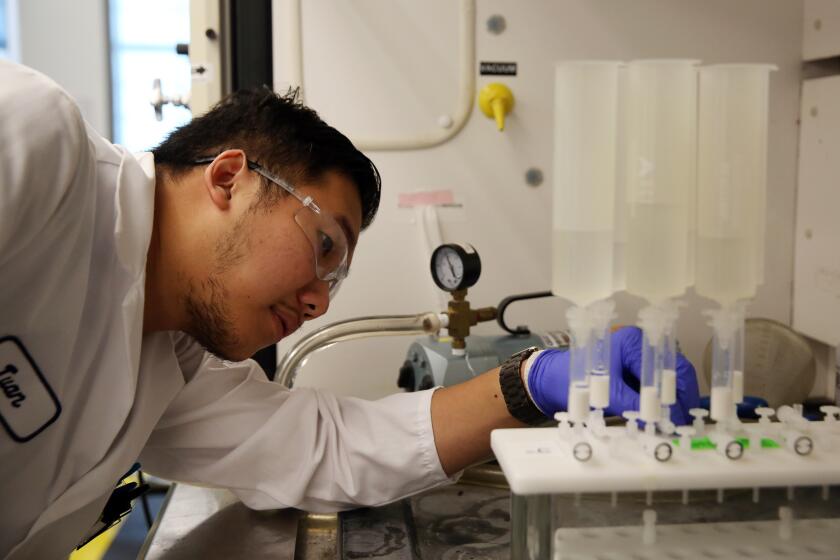Hereâs what you can (and canât) do about PFAS contamination in your water

WASHINGTON â After The Times reported last week that nearly 300 drinking water wells and other water sources in California had been contaminated with toxic chemicals linked to cancer, readers wanted to know what they could do. For many, it was the first time they had read about this class of chemicals, called perfluoroalkyl and polyfluoroalkyl substances â or PFAS. We talked to industry experts, and the following are their best answers to some of the most often-asked questions we received.
Will the water filter pitcher I have in my fridge remove PFAS?
If only it were that easy. Common water pitcher brands like Brita and Pur are perfectly fine if you want to reduce bad-tasting chlorine and contaminants like heavy metals. But they werenât designed to remove PFAS or even reduce their concentration in your tap water.
NSF International, a group that tests and certifies water filtration systems, lists 77 products that can reduce PFAS to below the Environmental Protection Agencyâs health advisory level. Some of them function like pitchers â you fill them manually and they donât have to be installed under your sink â but they do have to be docked into a filtration system that sits on your counter and has to be plugged in. They cost about $100-$150.
What type of home filtration system is best?
According to the Environmental Working Group, or EWG, a public health advocacy organization that has called for more regulation of PFAS, the gold standard for in-house filtration is a reverse osmosis filter, commonly called RO.
Reverse osmosis filters work by forcing water through a membrane that traps contaminants. These filters are considered the most effective, but they produce large amounts of wastewater â about three times as much water as they treat. Ranging from $200 to $1,800, a reverse osmosis system is typically the most expensive option and may require a professional plumber to install it under the sink.
The second best option is an activated carbon filter, which also goes under the sink. These systems are less expensive than reverse osmosis and their cartridges are often cheaper to replace.
EWG doesnât endorse any particular brand and NSF International gives you 10 different manufacturers to choose from.
There are several caveats to these recommendations.
First, the federal government does not regulate PFAS and there is no agreed-upon safe level for drinking water. Though NSF-certified filters are proven to reduce contaminant levels below the EPA guideline, thereâs debate among scientists and public health advocates about whether the federal governmentâs advisory level is too high.
For example, New Hampshire has the strictest PFAS standards in the country, which are significantly lower than the EPAâs level. Whether a home filtration system can meet these tighter standards is unclear.
Also, NSF certifies products to remove the two most common variants in the PFAS class â PFOA and PFOS â but there are thousands more. Itâs unknown how effective water filters are on the second generation of PFAS.
Nearly 300 drinking water wells and other water sources in California have been found to have traces of man-made chemicals linked to cancer.
I live near one of the contaminated wells identified by state testing. What should I do?
Just because you live close to a well with elevated levels of PFAS does not mean your tap water comes from that source. California has about 3,000 water providers, some of which purchase water from wholesalers that operate their own groundwater wells.
However, if your water does come from a utility with one or more contaminated wells, keep in mind that the PFAS level found in a well may not be the same as what comes out of your faucet. Some California water utilities have shut down contaminated wells, put them on âemergency-onlyâ status or processed their water through treatment plants. Others have begun blending contaminated sources with clean ones to lower the concentration.
If youâre concerned, the best course of action is to call your water provider.
Can I test my tap water for PFAS?
Yes, you can hire a certified laboratory to test your water. Itâs also possible to sample water yourself and send it to a laboratory, but itâs quite complicated. Because these chemicals have been used in a dizzying array of consumer products, cross-contamination is a serious concern.
Michiganâs Department of Environmental Quality has detailed instructions that warn against wearing latex gloves, water resistant clothing, or even certain kinds of lotion and sunscreen that contain the contaminants, while collecting samples. Itâs easy to inadvertently ruin a sample by wearing or touching something with PFAS in it.
If youâre interested in testing, California drinking water officials recommend that you contact a laboratory thatâs accredited for PFAS testing. However, testing is expensive. Prices range from $400 to $1,000 per sample.
I get my water from a private well. Should I wait for the state to test it or do it myself?
So far, Californiaâs State Water Resources Control Board has tested about 600 water sources â a small fraction of the whole system â and itâs unclear how quickly the state will move to require more. State officials have said they are prioritizing wells and other sources near areas that are known to be contaminated, such as military bases, wastewater treatment plants, municipal airports and landfills.
Unlike Michigan, which has committed to testing all of its public water providers, California has not said whether it will do the same, much less turn its attention to private drinking water wells. If you donât want to wait for the state to act, you can have a laboratory test your water.
The Los Angeles Times reviewed hundreds of pages of Pentagon documents and found California has more bases contaminated with the chemicals, known as PFAS, than any other state â at least 21 that exceed federal health guidelines.
Will my water bill go up if PFAS are found in my area?
Itâs possible. Although state-ordered PFAS testing is only beginning in California, already there are examples of water districts spending money to build new treatment facilities or purchasing clean water from elsewhere to replace wells that were shut down. Orange County officials have warned that if the chemicals spread throughout the groundwater basin, residents there could see their water bills rise by as much as 15%.
But because testing is ongoing, itâs unclear how widespread or how expensive the cleanup effort will ultimately be. California is still trying to understand the scale of the problem. As more testing is conducted, it seems likely that state officials will focus on the chemical companies and military branches that introduced PFAS into the environment. In the end, âwho pays?â may be a question for the courts.
More to Read
Get the L.A. Times Politics newsletter
Deeply reported insights into legislation, politics and policy from Sacramento, Washington and beyond. In your inbox three times per week.
You may occasionally receive promotional content from the Los Angeles Times.













